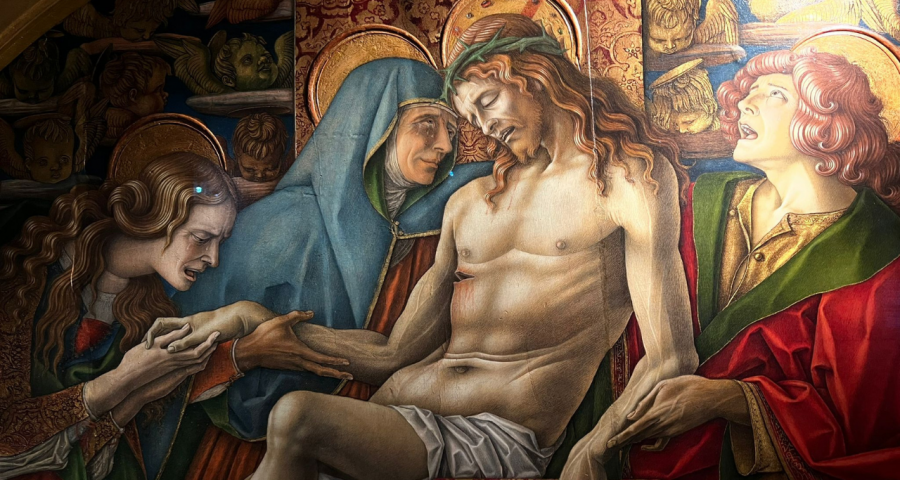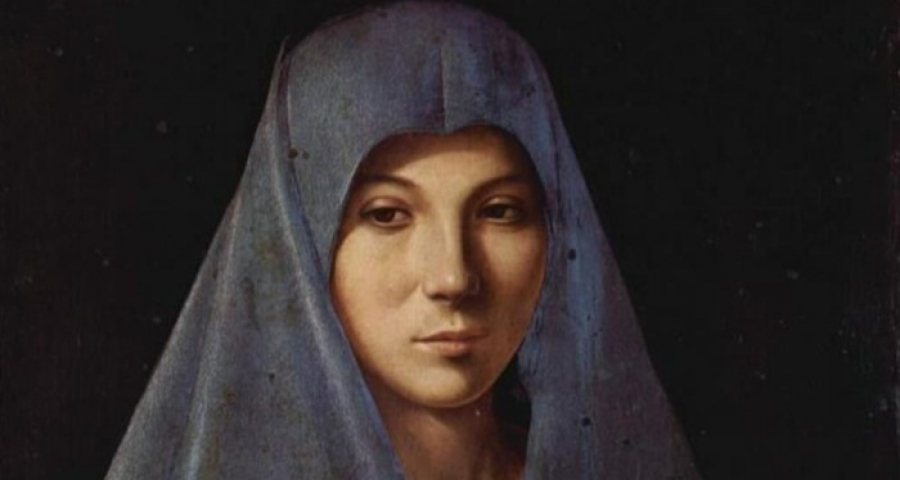The Star of the absence/11 - In a great biblical page we find horrors and a high and popular wisdom.
By Luigino Bruni
Published in Avvenire 12/02/2023
"God had summoned all the trees asking which of them would agree to give its wood for Haman’s cross. The fig tree said: “I am ready”; the vine said, "I'm ready." The palm tree said: "I wish to serve, therefore I am a symbol of Israel." Finally the bramble said: "I am the right tree, because the wicked are like thorny brambles" (...) The cross was made high enough to hang Haman and his ten sons on it".
Aggadat, Esther 61,62,73
Haman’s torture opens up an unexpected and fascinating scenario on its parallelism with the death of Christ. Just a hypothesis, but one that tells a story and speaks to the soul.
«The king said, “Impale him on it!” So they impaled Haman on the pole he had set up for Mordecai» (The Book of Esther 7.9-10). The fortunes of Haman the wicked and Mordecai the righteous had now been perfectly reversed.
The crucifixion of Haman is represented on the vault of the Sistine Chapel – in the plume at the altar, on the right. Haman crucified, therefore not hanged, an interesting detail that says a lot, especially after the case with Christ. Perhaps Michelangelo's (or his advisors') source was Canto XVII in Purgatory, where Dante meets Haman: «Then reigned within my lofty fantasy. One crucified, disdainful and ferocious, in countenance, and even thus was dying. Around him were the great Ahasuerus, Esther his wife, and the just Mordecai, who was in word and action so entire» (Purgatory, XVII, 26-30). In fact, an even more remote source of this strange crucifixion is the Latin version of the Bible of St. Jerome (the Vulgate), where the Greek word for "wood" (ξύλον) on which Haman was hung is translated three times with the word crux: «Iussit excelsam parari crucem» (Esther 5,14). Hence, the tradition of the crucifixion of Haman was something important in the Middle Ages, also intertwined with the often very difficult relationship between the Christian and Jewish communities. A tradition yet to be explored.
The Book of Esther is a total of many things, among which we also find the foundation of the Jewish festival of Purim, a word that means "destiny" or "fortune". In fact, as we can see, the fortunes of the protagonists are reversed during the course of the story. Purim is a celebration similar to our carnival – with masks, parties, wine and banquets… – but above all, Purim is very similar to the Roman Saturnalia. During the Roman Saturnalia, among other things, a princeps, a Saturn of the year, was elected by drawing lots, onto which every power was assigned, only for the days of the feast. Then he was generally dressed in multi-coloured clothes, where the colour red stood out. Today we know that the Babylonian Sacae are at the origin of the Roman Saturnalia. As the Babylonian priest Berosus tells us (History of Babylon, I), social relationships were reversed during the Sacee and the slaves ruled over their masters. Furthermore, as the Greek historian Dio Chrysostom also narrates, during the Sacee «the Persians take one of the prisoners sentenced to death and let him sit on the royal throne. They give him royal robes, and let him command, drink and revel and take advantage of the concubines of the king during those days, and no one prevents him from doing as he pleases. But then they strip him naked, scourge him and crucify him" (Orations, IV, vol. 1). The conversation is getting increasingly interesting.
The Jewish holiday of Purim probably originated in Babylon – its first reference can be found in the Book of Esther, a recent, post-Exilic text, and perhaps the word purim itself is of Babylonian origin. Hence the thesis of the great Scottish historian of religions James George Frazer that Purim too, not only the Saturnalia, was a more or less disguised form of the Babylonian festival of Sacee (Frazer, Saturnalia and related festivals). Thus far, we should not be particularly surprised, because we know that cultural crossbreeding in the ancient world was highly common for religions, rituals and celebrations. However, Frazer does not stop at the genesis of Purim (and of the Saturnalia); he goes much further, with hypotheses about the passion and death of Jesus Christ that are perhaps surprising and definitely fascinating.
First, a chronological piece of data. According to the Book of Esther, the extermination edict of Haman was issued on the 13th of the month of Nisan (Esther 3,12), and all the decisive events of the story take place within 3-4 days, therefore between the 13th and on the 15th or 16th of Nisan. In the Jewish world, the 15th of Nisan is the first day of Pesach, Passover. Hence Frazer's (bold) hypothesis: the passion and death of Jesus should be read and interpreted within the Roman Saturnalia and Jewish Purim: «The celebration of Saturnalia may have coincided with Pesach; and therefore Christ, as a convicted criminal, may have been handed over to the Roman soldiers, who amused themselves by treating him as the Saturn of the year». Then he asks himself: «Is it not possible that they may have coerced a convicted criminal into the tragic role, and thus Christ died like this while impersonating Haman…? What if the purple or scarlet robe, the reed sceptre and the crown of thorns, which the soldiers imposed on Christ, were the hallmarks of the Haman of the year?» (Frazer, The Crucifixion of Christ).
As the historian Andrea Damascelli summarizes in his fine essay on Frazer's theory: can we go so far as to say that «the Passion of Christ was a Purim?» (Passion and Purim). According to Frazer, it is probable. Indeed, «the original story of Esther and Mordecai was a drama similar to the passion of Christ. It was performed in Babylon, and the returning captives carried it from Babylon to Judea, where it was enacted as a drama. A chain of cause and events that we cannot trace meant that in this annual representation the part of the dying person was imposed on Jesus of Nazareth». Thus, the decisive question: is it possible that in that year – probably 30 AD – the death of Jesus was included in the feast of Purim, which perhaps coincided with the Saturnalia of the Roman soldiers, where Jesus ended up playing the part of Haman, the crucified?
Frazer and Damascelli then push this fascinating hypothesis even further, to the point of including a new and interesting interpretation of the personal story of Saint Paul (already advanced by R. Eisenman), based on a manuscript found in Qumran, from which a different reading of the quotation contained in the letter to the Galatians, «cursed is everyone who is hung on a pole» (Galatians 3,13) would emerge, connected to Esther. They also glimpse a new interpretation of Judas. Concerning Barabbas, Frazer writes: «If Jesus was the Haman of the year, who was Mordecai? Perhaps we can find him in the person of Barabbas», whose name, we know, means "son of the father" in Aramaic. In fact, «apparently Pilate tried to persuade the Jews to have Christ play the part of Barabbas. However, Pilate's attempt failed and Jesus ended up dying on the cross while impersonating Haman. Moreover, «the description of Jesus' triumphal entry into Jerusalem recalls the procession through the streets of Susa longed for by Haman and instead carried out by Mordecai» (Frazer, The Crucifixion of Christ).
It is also very interesting to cross these hypotheses with the rabbinic reading of the Book of Esther. The Talmud, a post-Christian text, in line with the Book of Esther, says that Haman was crucified on the second day of Pesach, which in the Gospels was also the day of Christ's crucifixion (Wild, The Crucifixion of Haman). Finally, it is very important to note the use of Psalm 22 in both the Christian and Jewish context. In the Gospel of Mark, this psalm – «Eli, Eli … My God, my God why have you forsaken me?» – is the text most commonly used to describe the passion and death of Christ. In the Talmud it is Esther who shouts that same psalm: having come to the king to make her request, Esther uttered «a cry of despair: 'Eli, Eli lama 'azavtani!"» (Megillah 15a). Wonderful stories, unfortunately almost unknown to us. After Haman's death-crucifixion, «That same day King Xerxes gave Queen Esther the estate of Haman, the enemy of the Jews. And Mordecai came into the presence of the king, for Esther had told how he was related to her. The king took off his signet ring, which he had reclaimed from Haman, and presented it to Mordecai. And Esther appointed him over Haman’s estate» (Esther 8.1-2). The reversal also affects Haman's economic properties and the use of the king's ring as a seal, signs that by now Mordecai had occupied Haman's place. However, Esther is still not satisfied. She knows that the extermination edict of the Jews had already been issued throughout the empire, and if she does not act immediately that decree will soon be operational and effective. And then, once again, the woman moves quickly: «“If it pleases the king,” she said, “and if he regards me with favor and thinks it the right thing to do, and if he is pleased with me, let an order be written overruling the dispatches that Haman son of Hammedatha, the Agagite, devised and wrote to destroy the Jews in all the king’s provinces"» (Esther 8,5).
This episode is also full of important meanings. It is not enough to celebrate on the day of a great success. In order for an important and serious collective action to conclude in the best and desired way, it is necessary to close all the details of the process, because it is sufficient for a single door to remain open for everything to disperse from that opening. Esther knows that the completion of her work does not lie in the death of Haman, but in the annulment of the decree. Thus, she does not linger at the party; she does not consume her great success but gets to work.
In complex processes, it is first essential to understand where their fulfillment lies and then continue the journey, without delay, even when one’s emotional energies seem exhausted during the first part of the job. Many actions never come to fruition, either because the great success of the first phase distracts us and prevents us from moving on to the second phase, or because all energies are exhausted in the celebration of the great victory and there is no strength left to close the last door. Esther is an ethical role model in this as well. Thus, « At once the royal secretaries were summoned - on the twenty-third day of the third month, the month of Sivan. They wrote out all Mordecai’s orders to the Jews, and to the satraps, governors and nobles of the 127 provinces stretching from India to Cush. These orders were written in the script of each province and the language of each people and also to the Jews in their own script and language» (Esther 8,9-10).
The parallelism between the crucifixion of Haman and that of Christ is only a hypothesis, but it has been present and active for centuries in both Christian and Jewish circles, and, unfortunately, it has sometimes been used by Christians as an anti-Semitic pretext. Moreover, when Michelangelo immortalized Haman with his gesture he made that parallelism eternal and with the infinite strength of his art he redeemed Haman from his hell - Dante meets Haman in Purgatory, not in Hell where we, little ones, expected it. These too are pages not written by an ancient biblical author but penned by the prophetic soul of great art, which is above all a place of redemption for all victims. Because, after Golgotha, every time a person ends up on a cross, an embodied echo of Christ's death returns. And a soul of the Christian people perceived that even the torture of a cursed man in the Bible had foretold something of the cross of Jesus, who dies between two cursed companions. The redemption of the world will be accomplished on the day in which the last person to be crucified has experienced resurrection.













